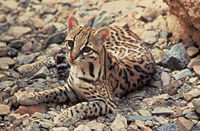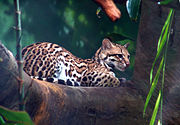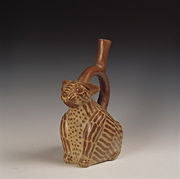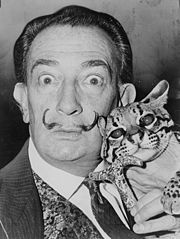Ocelot
| Ocelot[1] | ||||||||||||||
|---|---|---|---|---|---|---|---|---|---|---|---|---|---|---|
 |
||||||||||||||
| Conservation status | ||||||||||||||
| Scientific classification | ||||||||||||||
|
||||||||||||||
| Binomial name | ||||||||||||||
| Leopardus pardalis (Linnaeus, 1758) |
||||||||||||||
 Ocelot range
|
The Ocelot (Leopardus pardalis), also known as the Painted Leopard, McKenney's Wildcat, Jaguatirica (in Brazil) or Manigordo (in Costa Rica), is a wild cat distributed over South and Central America and Mexico, but has been reported as far north as Texas and in Trinidad, in the Caribbean.
The Ocelot's appearance is similar to that of the domestic cat. Its fur resembles that of a Clouded Leopard or Jaguar and was once regarded as particularly valuable. As a result, hundreds of thousands of Ocelots have been killed for their fur. The feline was classified a "vulnerable" endangered species from the 1980s until 1996, but is now generally considered "least concern" by the 2006 IUCN Red List.
Contents |
Taxonomy and name
The name ocelot comes from the Nahuatl word ōcēlōtl (pronounced [oːˈseːloːtɬ]), which usually refers to the Jaguar (Panthera onca) rather than the Ocelot.[3][4][5][6]
Subspecies
The following are the currently recognized subspecies:[1]
- Leopardus pardalis pardalis, Amazon Rainforest
- Leopardus pardalis aequatorialis, northern Andes and Central America
- Leopardus pardalis albescens, Mexico, southwestern Texas
- Leopardus pardalis melanurus, Venezuela, Guyana, Trinidad, Barbados, Grenada
- Leopardus pardalis mitis, Argentina, Paraguay
- Leopardus pardalis nelsoni, Mexico
- Leopardus pardalis pseudopardalis, Colombia
- Leopardus pardalis puseaus, Ecuador
- Leopardus pardalis sonoriensis, Mexico
- Leopardus pardalis steinbachi, Bolivia
Physical characteristics
It can be up to 1 m (3'2") in length, plus 45 cm (1'6") tail length, and weighs 11.5–16 kg (25–35 pounds)[7], making it the largest of the generally dainty Leopardus wild cat genus. While similar in appearance to the Oncilla and the Margay, which inhabit the same region, the Ocelot is larger. The Ocelot has the lowest resting body temperature of any feline. It has a tawny to reddish brown coat marked with black spots and rosettes. The fur is short, and lighter beneath. There is a single white spot on the back of each of its ears, and there are two black lines on either side of its face. It has a black-banded tail.[8]
Behavior

The Ocelot is mostly nocturnal and very territorial. It will fight fiercely, sometimes to the death, in territorial disputes. Like most felines, it is solitary, usually meeting only to mate. However, during the day it rests in trees or other dense foliage, and will occasionally share its spot with another Ocelot of the same sex. When mating, the female will find a den in a cave in a rocky bluff, a hollow tree, or a dense (preferably thorny) thicket. The gestation period is estimated to be 70 days. Generally the female will have 2–4 kittens, born in the autumn with their eyes closed and a thin covering of hair.
While the Ocelot is well equipped for an arboreal lifestyle and will sometimes take to the trees, it is mostly terrestrial. Ocelots hunt over a range of 18 km² (7 sq mi), taking mostly small mammals (deer, rabbits and various rodents), reptiles and amphibians (lizards, frogs, and turtles), crabs, birds and fish.[8] Almost all of the prey that the Ocelot hunts is far smaller than itself. Studies suggest that it follows and finds prey via odor trails, but the Ocelot also has very keen vision, including night vision.
Distribution and habitat

The Ocelot is distributed over South and Central America and Mexico, but has been reported as far north as Texas and in Trinidad, in the Caribbean.
The Ocelot once inhabited the chaparral thickets of the Gulf coast in south and eastern Texas, and was found in Arizona. In the United States, it now ranges only in several small areas of dense thicket in South Texas. The Ocelot's continued presence in the U.S. is questionable, due largely to the introduction of dogs, the loss of habitat, and the introduction of highways. Young male Ocelots are frequently killed by cars during their search for a territory. The feline was classified a "vulnerable" endangered species from the 1980s until 1996, but is now generally considered "least concern" by the 2006 IUCN Red List.[2] The Texas Ocelot subspecies, Leopardus pardalis albescens, is still classified as endangered as of the IUCN's 2006 red list.[9]
Other

Like many wild cats, it is occasionally kept as a pet. Salvador Dalí frequently traveled with his pet Ocelot, even bringing it aboard the luxury cruise liner SS France.[10][11]
The Moche people of ancient Peru worshipped animals and often depicted the Ocelot in their art.[12]
References
- ↑ 1.0 1.1 Wozencraft, W. C. (16 November 2005). Wilson, D. E., and Reeder, D. M. (eds). ed.. Mammal Species of the World (3rd edition ed.). Johns Hopkins University Press. pp. 539. ISBN 0-801-88221-4. http://www.bucknell.edu/msw3.
- ↑ 2.0 2.1 Cat Specialist Group (2002). Leopardus pardalis. 2006 IUCN Red List of Threatened Species. IUCN 2006. Retrieved on 12 May 2006. Database entry includes justification for why this species is of least concern
- ↑ "ocelot, n.". Oxford English Dictionary (draft revision Mar. 2004 ed.).
- ↑ Pickett, Joseph P. et al. (eds.) (2000). "ocelot". The American Heritage Dictionary of the English Language (4th ed. ed.). Boston: Houghton Mifflin.
- ↑ Karttunen, Frances (1983). An Analytical Dictionary of Nahuatl. Austin: University of Texas Press. pp. p. 176.
- ↑ Lockhart, James (2001). Nahuatl as Written: Lessons in Older Written Nahuatl, with Copious Examples and Texts. Stanford: Stanford University Press. pp. p. 228.
- ↑ Kindersley, Dorling (2001,2005). Animal. New York City: DK Publishing. ISBN 0-7894-7764-5.
- ↑ 8.0 8.1 The Encyclopedia of World Wildlife, Mike and Peggy Briggs, Pargaon Books. 2006 edition
- ↑ Cat Specialist. Group (2002). Leopardus pardalis ssp. albescens. 2006 IUCN Red List of Threatened Species. IUCN 2006. Retrieved on 12 May 2006. Database entry includes justification for why this species is endangered
- ↑ Photo of silver optical piece with hand-cut collage of Dali, including picture of him with his Ocelot.
- ↑ Huggler, Justin; "Chic ship too toxic for scrapping" from ssmaritime.com
- ↑ Berrin, Katherine & Larco Museum. The Spirit of Ancient Peru:Treasures from the Museo Arqueológico Rafael Larco Herrera. New York: Thames and Hudson, 1997.
External links
|
||||||||||||||||||||||||||||||||||||||||||||||||||||||